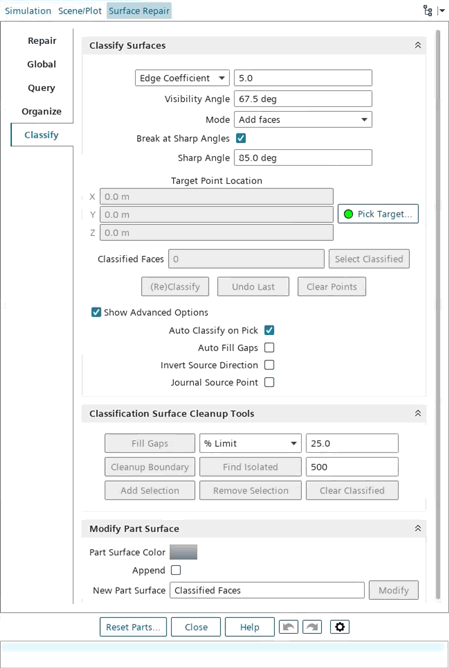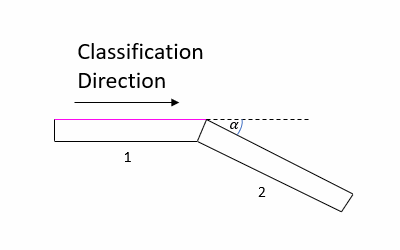Classify Reference
In Surface Repair, you can Classify faces based on specified settings and create corresponding part surfaces. You can influence the classification process using the settings in the Classify tab.

Classify Surfaces
These options define the classification settings and the target point locations for the selected face subset.
- Source Distance
- Defines the distance
between the source point and target point.
- Edge Coefficient—the distance between the source and target points is the average edge size of the target face multiplied by the coefficient that you specify.
- Specify Distance—you directly specify the absolute distance between the source and target points.
- Visibility Angle
- Defines the maximum angle [0° - 90°] between the center of source point and the normal of a face on the surface (that is, the angle at which the face center is visible by the source point). Any face where the angle between the face normal and the source point is below the specified value are included in the classification.
- Mode
- For each target point specified, allows you to Add Faces or Remove Faces from the classification subset.
- Break at Sharp Angles
- When activated, adjacent
faces with a dihedral angle greater than the specified Sharp Angle are not included in the
classification subset. For example:

- Target Point Location
- Pick Target... allows you to position the target point directly in the Surface Repair scene. The target point coordinates are read-only. In the Repair Surface scene, target points are indicated in green and source points are indicated in red.
- Classified Faces
- Displays the accumulated face count for the classified subset.
- Select Classified
- When selected, highlights the current faces included in the classification subset in the Repair Surface scene.
- (Re)Classify
- Allows you to re-perform the classification using the existing target point. To improve the classification, you can modify the classification settings such as the Source Distance or Visibility Angle before your reclassify the subset. When the classification subset is reclassified the previous classification result is deleted.
- Undo Last
- Removes the most recent action from the classification subset. If no unique faces are added to the classification result this option is deactivated. If you have activated Auto Fill Gaps, this option removes both the classification faces and gap fill faces from the classification subset. Otherwise, only the manual gap fill faces or most recent classification is removed from the classification subset.
- Clear Points
- Deletes the target and source points displayed in the Repair Surface scene.
Advanced Options
Available when you activate Show Advanced Options.
- Auto Classify on Pick
- When activated, Simcenter STAR-CCM+ automatically adds or removes (depending on the specified Mode) faces defined by the target point and classification settings to the classification subset. When you deactivate this option, Simcenter STAR-CCM+ only creates the target and source points, without adding or removing faces. To produce the classification subset, select (Re)Classify.
- Auto Fill Gaps
- When activated, Simcenter STAR-CCM+ automatically locates closed loop gaps which satisfy the parameters set under the Fill Gap cleanup tool. These faces are automatically added to the classification subset.
- Invert Source Direction
- Simcenter STAR-CCM+ requires all classified faces to have the same face normal orientation. For inconsistent face orientation (a negative face normal surface enclosed by positive face normal surfaces or vice versa), this option allows you to reverse the direction of the normal from the target point to the source point, to provide a consistent classification of the surface.
- Journal Source Point
- When you record the classification process in a java macro, the target point is recorded by default. If you activate this property, the source point is recorded to the macro instead of the target point, allowing you greater versatility when applied to design variants.
Classification Surface Cleanup Tools
These options allow you to modify the classification subset by adding closed loop gaps and removing isolated surfaces.
- Fill Gaps
- Allows you to automatically
add closed loop gaps to the classified face subset. The fill gaps operation
is independent of the current source point location. Closed loops are only
located and filled if the gap contains less faces than the face count limit.
You can specify the maximum face count limit using one of the following
options:
- % Limit—allows you to define a percentage of the current classified subset.
- Face Limit—allows you to define an absolute face count limit.
- Cleanup Boundary
- When selected, Simcenter STAR-CCM+ automatically adds or
removes faces from the classification subset to improve the boundary between
the classification subset and the unclassified faces. A face is only
included in the cleanup process if it has a certain number of surrounding
faces which do not belong to the same subset (classified or unclassified).
This number of surrounding faces depend on the face shape:
- Triangle—two or more
- Quadrilateral—three or more
- Find Isolated
- Allows you to locate distinct and separate isolated surfaces (islands) in the target surface. When selected, any isolated faces below the face count limit are identified. You can remove these faces from the classification subset using the Remove Selection option.
- Add Selection
- Allows you to add faces selected manually in the Repair Surface scene to the classification subset.
- Remove Selection
- Allows you to remove faces selected manually in the Repair Surface scene from the classification subset.
- Clear Classified
- Deletes the current classification subset.
Modify Part Surface
These options allow you to define a new part surface for the classified face subset. For more information, see Part Controls.